How To Do Wood Staining
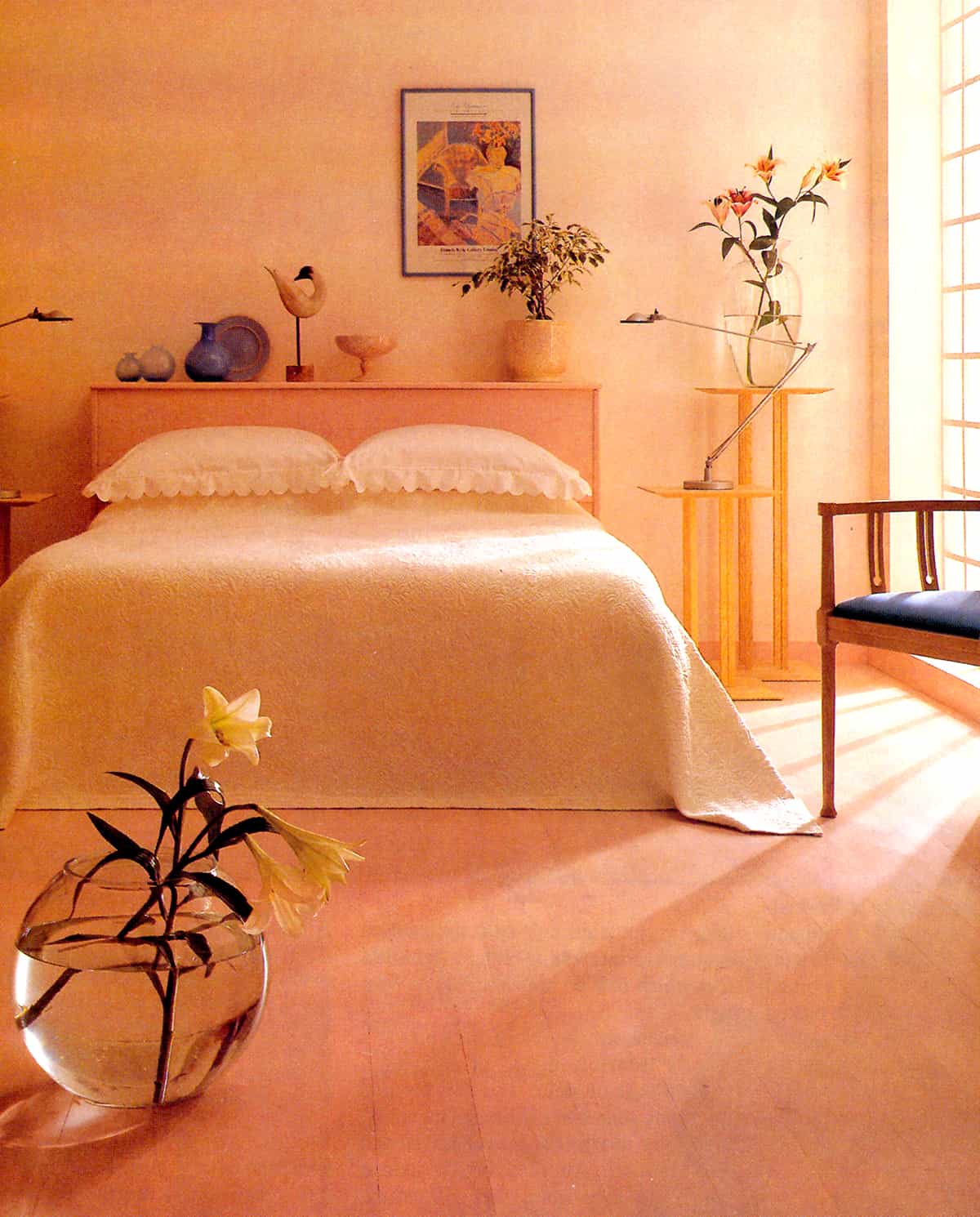
The warm tones of a pastel pink paint stain successfully soften and meld bare floorboards into a comfortable bedroom decor. The same wood staining is used again on the headboard and skirting boards to complete the picture.
We show you here how to do wood staining the easy way. Stained timber is a way of changing the wood’s color without sacrificing the character of the grain and knots. This can be done discreetly using wood tones to improve the natural shade or imitate a more expensive timber.
Or you can completely transform the appearance of the wood with a whole spectrum of un-wood-like rainbow colors. Brilliant patterns and motifs can be developed from a widely varied palette of colors to pick out molded details in carved wood and cheer up timber.
In contrast, modern pastel, semi-translucent, grain-displaying paints mimic the soft, faded appeal and weathered finish of old country cottage joinery and furniture.
By reproducing the muted colors and distressed finish of genuinely matured rustic features, they can blend new timber articles with old or bring recently stripped older pieces back to life. The wood staining effect works equally well on floorboards and paneling giving the timber an instantly seasoned quality and the room a peaceful atmosphere.
Objects That You Can Use For Staining
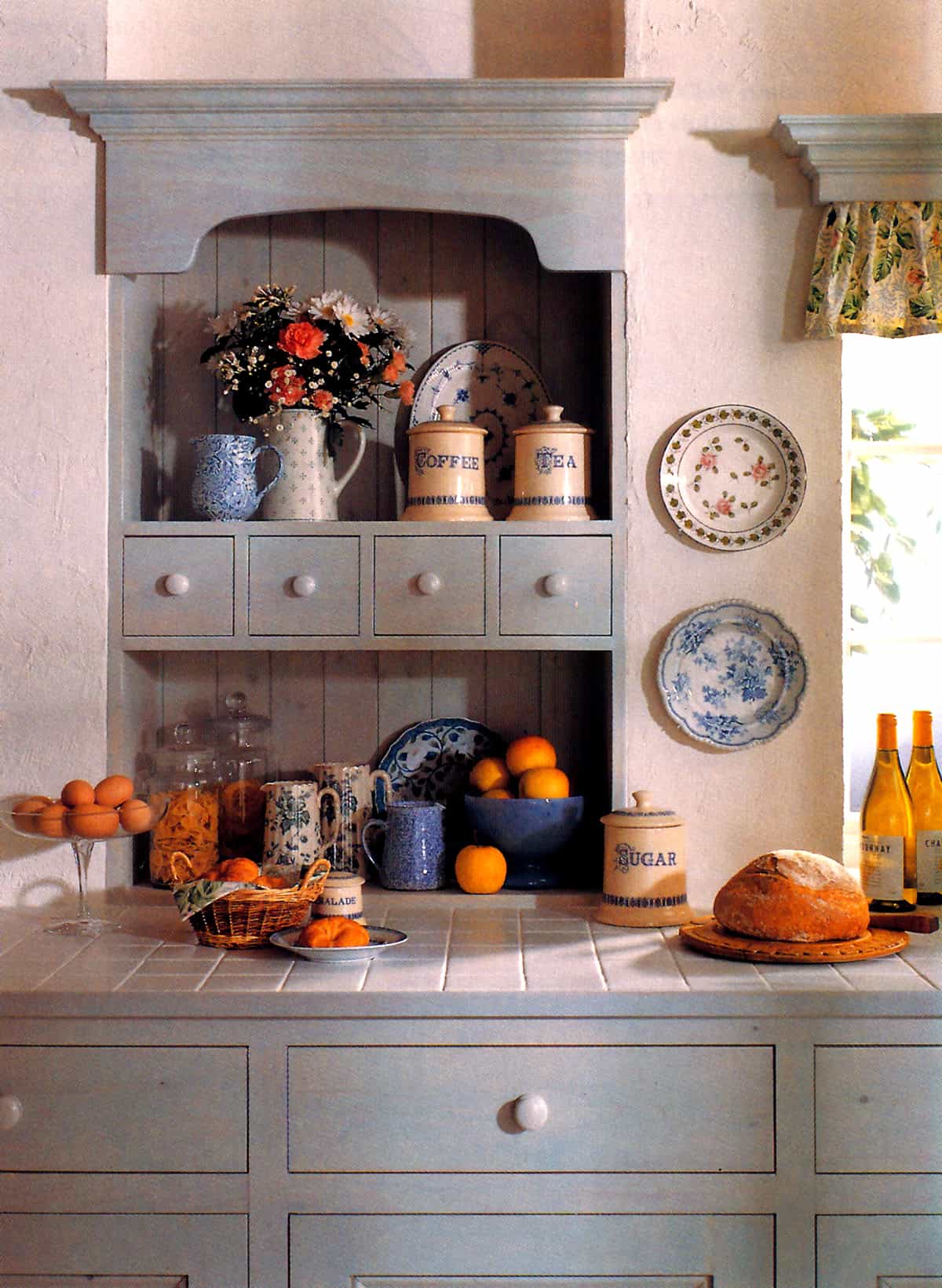
Even after wood staining in pale grey, the grain in the wood of these display units and drawers is clearly visible. Fascinating shadows in the timber emerge from the stain, conveying a worn look that is totally compatible with a matured country kitchen.
Wooden furniture responds well to wood staining, either to restore its original hue or mellow new pieces to blend in with older ones. Old pine pieces that have been stripped can often look slightly grey and bleached; a coat or two of a golden stain re-develops its former warmth.
For pine, avoid red tones of stain, like mahogany, which are better for close-grained woods. Antique pine tones are available, but test them first. If necessary, mix different tones until you achieve the desired effect.
Skirtings and doors. Wood staining rather than painting woodwork around the house makes a pleasant change, presenting a more natural or delicate look than conventional gloss and eggshell finishes. Slightly subdued, worn shades integrate beautifully with muted pastels and sheer fabrics, creating a soft focus in the room.
Timber floorboards or paneling offer a broad surface for color treatment. Decorating a wooden floor is infinitely cheaper than laying carpet or tiles. Already divided into parallel strips, the boards can be stained in stripes, panels, zigzags or mosaics of different shades.
Staining a checkerboard layout simulates the crisp, clean lines of a tiled floor very realistically. Mark out the grid carefully on the floor before you start working in the stains, using masking tape to define the margins. As an extra precaution to prevent the stain bleeding from one area to another, score the borders of the pattern elements lightly with a sharp knife.
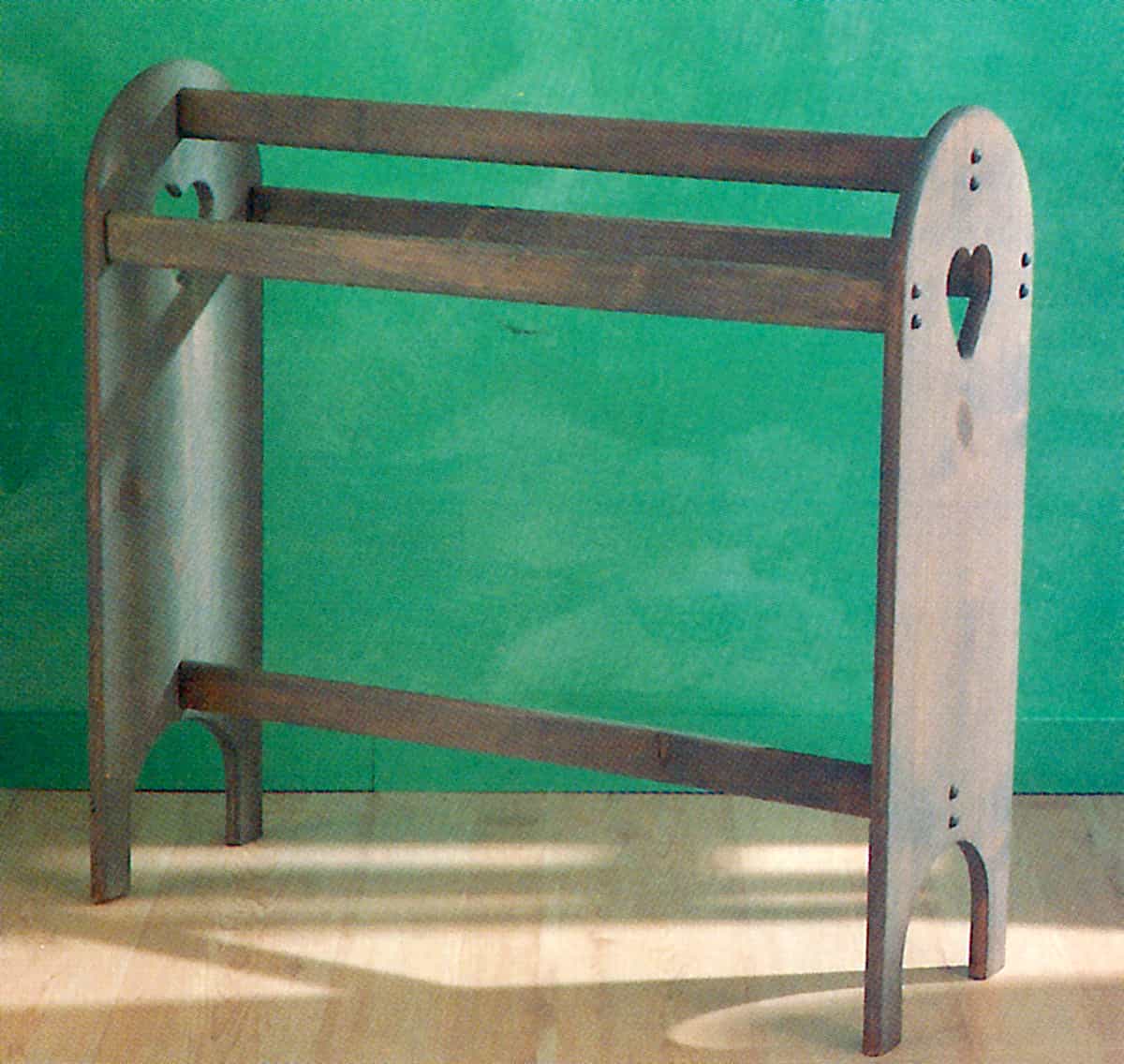
Staining small wooden items of furniture like this free-standing towel rail grants them a peculiar distinction. The mottled effect of color-stained wood blends particularly effectively with the blotchiness on color-washed walls.
Household equipment
Plain wooden items around the house gain individuality when stained, particularly if you add a special pattern or motif of your own for extra distinction. In the kitchen a bread bin or paper roll dispenser can be picked out in a rustic stain. In the bathroom, towel rails and accessories retain a naturally grained appearance while adopting a color that ties in with the rest of the design scheme.
Types of Stain
Stains for wood fall into two main types: those, usually put on with a cloth, that sink into the wood but give no surface protection, and those incorporated in a varnish so that color and protection are imparted at the same time.
Stain on its own comes in a range of wood and primary colors. They can be water or oil-based. Many stains tend to soak in quickly which can make it difficult to apply evenly, especially with a brush. If you brush on the dye, more tends to soak into the wood where you first touch it with the bristles. When the wood does take up the stain unevenly the surface acquires an interesting blotchy, textured feel which can be appealing in its own right.
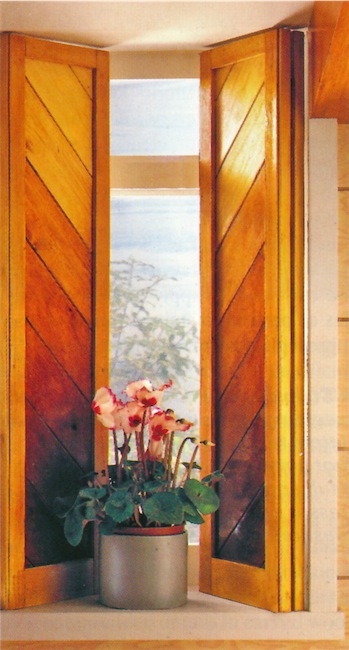
The gradation of shades in these paneled shutters is achieved by working down the panels, giving each board one more coat of the same colored wood stain than its neighbor above.
A clean, lint-free cloth often proves a more satisfactory means of applying a smooth coat of stain. The pad absorbs the runny stain and distributes it evenly, especially into the crevices of carved and turned wood. Alternatively, a sponge paint pad is a good way of getting consistent cover, except in tight corners.
The wood itself has to be protected by wax polish, oil or clear varnish after using this type of stain. When you prepare the wood thoroughly in the first place and apply several coats of varnish over the stained timbers, the finish should be robust enough to withstand wear-and-tear for many years.
Semi-translucent paint
This paint displays the grain like a stain, allowing the natural beauty of the timber to show through, but instead of wood tones it comes in a range of pale pastel colors. A combination of chalky green, blue and white produces a cool, refreshing impression; misty pink and peach add a warmer, comforting touch.
The paint is easy to apply and protects woodwork with a tough, low-sheen coating that is quick to clean and resistant to damage. Brush it on evenly in the direction of the grain and leave to dry for at least six hours before re-applying; two coats are recommended. For good results, this paint needs to be applied to a new light-colored or stripped wood in which a strong fingerprint of the grain is evident.
>
>
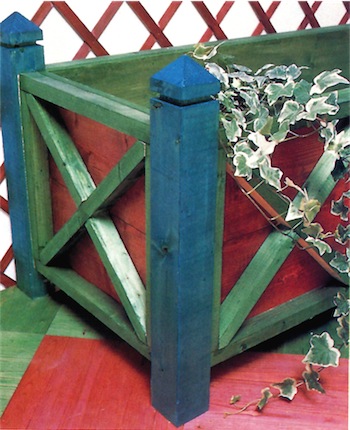
These lovely bright stain colors pick out the decorative details of an unusual plant trough for the garden. It’s a good idea to choose your flowers to complement the color scheme.
Exterior stains
Special micro-porous sealers or stains must be used on external woodwork.
Applying wood stains
Whatever type of stain you decide to use it is important to do a test first on an inconspicuous spot to check the color. The result depends on the color and grain of the original wood and how much of the stain it absorbs.
Remember also that further coats of stain will deepen the color. So let the first coat be absorbed and test a smaller area with another coat on top. You can mix stain colors of the same type to achieve the shade you prefer.
You should also test the effect of the final finish you intend to use over the stain; most waxes and oils tend to darken surfaces while even clear varnish contributes a yellowish hue.
Home Depot have a video showing you “How to Stain Wood”
Reference: The Country Look—Decor & Crafts

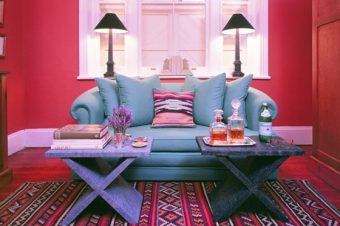
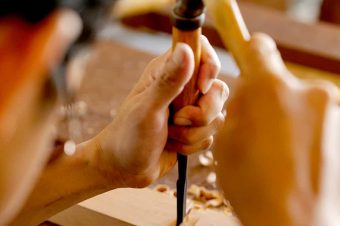
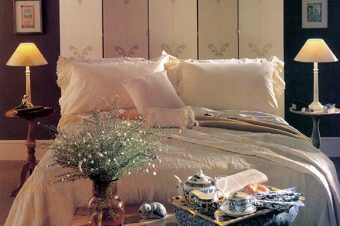




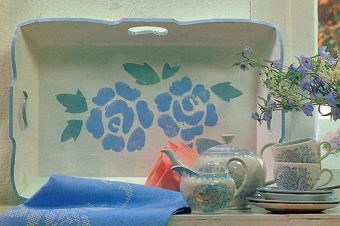
12 Responses
Janek
A wood stain normally penetrates deep into the wood so the answer is no you cannot, all you can do is go for a darker stain.
Janek
A wood stain needs bare wood so that it can penetrate and “stain” the wood, any oiled or treated surface might not work when you use a wood stain. Rather use a polyurethane that has a color stain built in. You will have to give the wood a light sanding so that the polyurethane can stick.
Harry
I bought the wrong stain for my wood fence I want to take it off. I only did half my fence but now I want to do the transparent one. Is there anyway I can take off that wood stain color
johnkaiser 22
I bought a wooden tabletop from ikea and its been previously oiled. Will I need to sand it down before I apply wood stain to it?
Ollie
Katie
With that dark color you need a light color, I suggest that the wood must be as light as possible, such as a light oak stain.
Adam
We are going to renovate the house & my living area has a deep, dark eggplant highlight wall. What color wooden stain would go nicely with this color? I am open to any & all suggestions. I’m having a difficult time coming up with my own inspirations considering I’m so stressed with this entire moving debacle.
Janek
Stains are made to be permanent so I do not think you can get that stain out, so you will have to replace the carpet.
Dark_LovexXx
I spilled a gallon of pecan colored lumber stain inside my beige carpet as well as its dried inside today. I dont recognize what chemical would remove it. I can’t substitute the carpet I am renting an apartment.
Janek
For an exterior table use a UV resistant polyurethane varnish. Sand with fine glasspaper between coats.
unbleevable39
I have a wooden terrace table that I have sanded back to bare lumber & stained . How do I get a good finish on the table?
Janek
Most stains are water soluble and are quite cheap. Ask your hardware guy they will help.
PillowMan1234
I wish To stain a bunny hutch I ordered a darker color. Can anybody suggest a superior non-toxic lumber stain that I can get from a hardware shop including Lowe’s. Is there anything water soluble that will be OK…is this true?